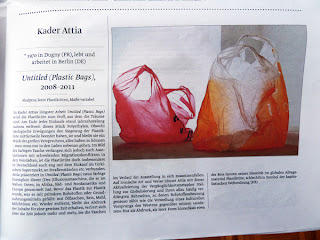During a
visit with my parents in the end of January I had my son’s official order to
leave him alone with his grandparents “for a long time” and dutifully obeyed by
going to see another museum. It is slightly strange to ‘return’ to the city
where one grew up after more than twenty years and realize how many things have
indeed changed. Don’t get me wrong, I did visit my parents during all those
years, but somehow I never took the chance to explore the city that I left when
I went off to study at the university in 1985. I had never been to the ZKM yet, a museum for contemporary art and media, which officially opened in 1989, so I was glad I finally got a chance.
 |
| On the way from the streetcar-stop to the entrance of ZKM |
I had found
out beforehand that the exhibition “The Global Contemporary – Art Worlds after
1989” was on and thought that this would be an interesting destination. www.global-contemporary.de
The ZKM is located in what once used to be a production site for weapons and
ammunition. Tens of thousands of enslaved laborers from Eastern
Europe were working here during World War II, and more than 600
died on the site. Something I did not know when I grew up here.
The huge
buildings are also home to the Art
Academy
However,
this was an exhibition that I felt inadequately prepared for while I was
walking through the rooms. I definitely should have taken the time and read the
introductory pages of the paper that accompanies the exhibition before
entering, it might have helped to overcome this feeling of incompetence. But
because I had other plans for the afternoon I felt as if I did not have enough
time to do that, and went in open for the challenge.
The first
rooms gave a historic and theoretic overview of the events that the curators
say set the stage for what is happening in the art world right now. The year
1989, with its political upheavals, the invention of the WorldWideWeb, the
launching of the first GPS satellite, amongst others, is considered to be the year
that introduced globalization, a term not really heard of or used before.
Today, everything in the world seems to be subject to globalization, and the
art world is no exemption. A major claim – as far as I understood – is that
contemporary art today is not only “new art” made today, but a new kind of art,
produced under totally different conditions. The exhibition wants to present
global practices that have influenced and shaped modern art as much as the new
media had just before that.
The
exhibition itself is divided into seven separate sections that are not clearly
separated, however, so the viewer keeps changing back and forth between the
different sections unless you kept referring to the floor plan in the middle of
the catalogue paper. Which gave me a feeling of being slightly lost between
nothing and everything. The sections have titles such as “Lost in translation”,
“World Art” or “Art as product”. All participating artists are each presented
briefly in the catalogue paper:
An
artist-in-residence-programme is also part of the exhibition, and the artists
included are presented in the catalogue paper with individual statements, such
as this one by Ruth Sacks.
Many of the
works presented are fotos, C-prints or videos, but ‘sculptures’, mixed media
installation or paintings appear just as well:
 |
| Sculpture made from colored plastic bags, as shown in catalogue paper |
In the
section titled “Border line experiences” I particularly liked Leila Pazooki’s
piece of
light art “Moments of Glory” (find a picture here), in which she sheds light on
patronizing comparisons used in media coverage of so-called budding artists.
As with
almost any modern art exhibition, there was little textile art, except for some
pieces in mixed media installations, among them “Para-Production”, a huge
textile experiment by Ni Haifeng in which visitors could become collaborators
in the production of the piece by sitting down and sewing a few pieces onto the pieace already on display.
Somewhere
in the exhibition I read that the central question of the art world is a
problem of inclusion and exclusion – the so-called third-world countries used
to be excluded from the world art market and are now much more at the center
than before, whereas the so-called western world is being pushed to the edges,
is on the way to exclusion. Wouldn’t it be nice if quilts could leave their
place where they are still being excluded from the world art market, and enter
a stage where they are included in the definition of contemporary art works? Or
should we just start calling them mixed media installations, or performance, or
something like that? Perhaps we would receive more attention that way.
Too bad
that I had more plans for the afternoon, it might have well been worth staying
on to get a better understanding of what I was seeing. And the show closed at
the Karlsruhe



It's not so much that quilts are excluded from the world art market (look at Tracey Emin) but that people from the quilt world are not regarded as "real artists". But don't feel bad -- the vast majority of painters and photographers in the world are also excluded from the world art market because they don't have the credentials or connections.
ReplyDelete